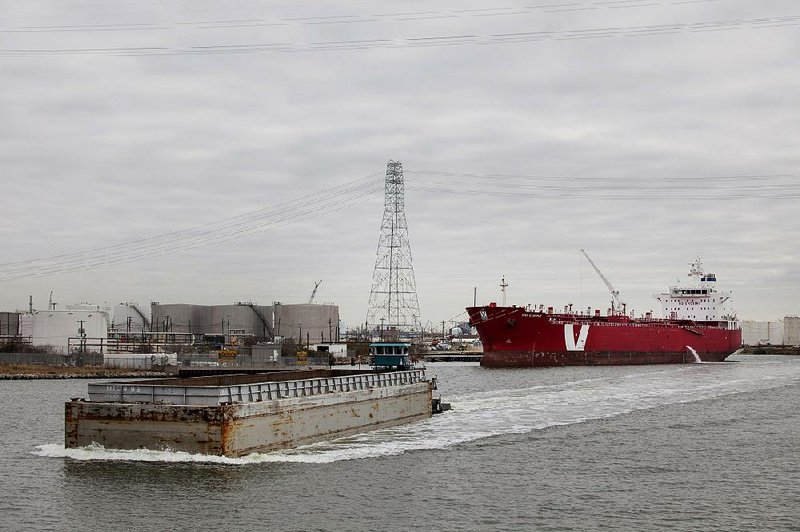It takes an expert pilot to pull off the Texas Chicken.
The maneuver, in which passing ships set up for a head-on collision and use each other’s wave pressure to swerve safely past, is the only way to handle two-way traffic in the Houston Ship Channel, which connects downtown with the Galveston Bay and the Gulf of Mexico. The narrow waterway is used by some 400 vessels every day, from barges to immense tankers.
“We’re still trying to stuff these bigger ships up these tiny ditches,” said Capt. Mike Morris, presiding officer of the Houston Pilots, the corps of 95 mariners who drive ships on the six-hour trip up the channel. “Everywhere you look in the port, we’re expanding.”
All along this 52-mile shipping lane, there are signs of the energy resurgence that BP Plc says might enable the U.S. to meet all its own needs by 2035. Construction cranes and excavators line the banks, and there are pipes large enough for a person to crawl through waiting to be buried.
The channel is a symbol of the boom that surrounds it, with truckers getting $5,000 signing bonuses, students flocking to midnight welding classes and out-of-town workers filling up recreational-vehicle parks.
Much of the record U.S. growth in oil and gas output is getting squeezed through Houston, the country’s largest export gateway and the core of the biggest refining region. An average day on the water in 2013 saw 38 tankers, 22 freighters, one cruise ship, 345 tows, six public vessels, 297 ferries, 25 other transits and 75 ships in port, Coast Guard data show.
As companies spend an unprecedented $35 billion on expansion projects along the Houston Ship Channel by next year, some are beginning to question how well the century-old infrastructure can keep up. A shortfall in federal maintenance funding means a buildup of sediment is threatening to disrupt commerce that totals an estimated $330 million a day.
At the turn of the 20th century, Houston was a provincial, cotton-trading hub with only slightly more inhabitants than its coastal neighbor to the east, Galveston, home to the region’s deep-water port. Buffalo Bayou, less than 10 feet deep, was most of the navigable water between the cities.
After a hurricane battered Galveston in September 1900, U.S. Rep. Tom Ball successfully lobbied Congress to dredge the ship channel to a depth of 25 feet.
HOUSTON’S ‘BOUNTY’
“At that time, Houston was still a small town,” said Janiece Longoria, chairman of the Port of Houston Authority. “Houston owes all its bounty to the ship channel.”
The resulting waterway is 4 miles longer than the Panama Canal. Today, about 8 percent of U.S. refining capacity lines its shores. It’s home to the country’s largest petrochemical complex, and pipelines link the spot with the oil hub in Cushing, Okla.; Chicago and New York Harbor; and oilfields throughout the Midwest and Texas.
All those connections make the ship channel prime real estate in the midst of an energy production boom in the U.S. Increased use of horizontal drilling and hydraulic fracturing has increased output of crude oil, natural gas and petrochemical feedstocks, and legal and logistical export barriers have reduced U.S. prices relative to the rest of the world. U.S. benchmark West Texas Intermediate cost $102.45 a barrel recently, compared with $110.15 for European Brent.
The ship channel has enough capacity to meet the demand of the surrounding industries, said Charlie Jenkins, the Port Authority’s vice president of strategic planning. The number of deep-water docks will jump to 45 from 10 in the next few years, said Bill Diehl,president of the Greater Houston Port Bureau.
Vessel traffic in the channel actually declined in 2013 because of bigger ships and fewer oil imports, Jenkins said.
Transits by tugboats and ships each fell 6.3 percent to 125,894 and 22,446, respectively, according to the Coast Guard’s Vessel Traffic Service. Total transits fell 4.2 percent to 159,767, plus another 108,357 ferry crossings, data show.
Capacity may be stretched as companies plan to spend $35 billion on new projects and expansions along the ship channel, according to a 2012 Greater Houston Port Bureau survey. That’s creating 265,800 jobs, the study showed. The port’s total economic impact amounts to more than $178.5 billion in Texas and $499 billion nationwide, according to the Port Authority.
The biggest vessels have had to carry less than their maximum cargoes because of sediment building up in the channel. The equivalent of 1 million dump trucks gets removed from the channel every year, Jenkins said. Silt from the bayou and river that feed into the channel have cut 2 feet off the 45-foot depth, according to Diehl.
Dredging costs about $50 million a year, $20 million more than the federal government allocated for 2014, Jenkins said. The Port of Houston contributes more than $90 million in taxes to a trust fund that’s earmarked for harbor maintenance, and receives only about $20 million to $25 million back, according to the Port Authority.
Because of previous funding shortfalls, the port actually needs $70 million to catch up, Jenkins said, and it’s pitching in with its own funds. Bills introduced in the U.S. House of Representatives in the past two years that would help match spending to revenue stalled.
Information for this article was contributed by Jack Kaskey of Bloomberg News.
Business, Pages 21 on 02/25/2014
